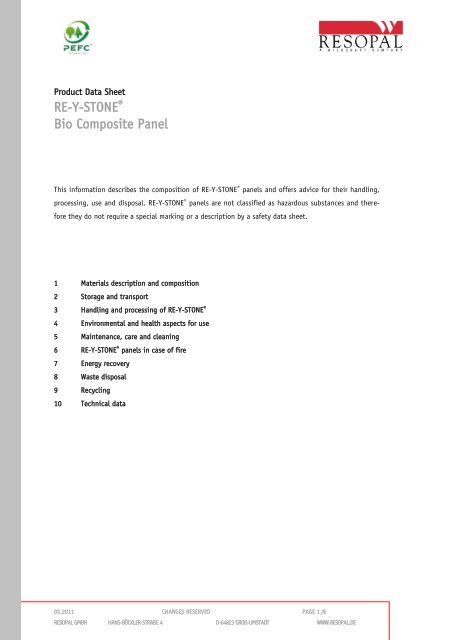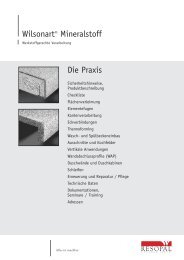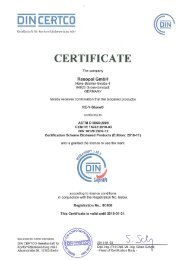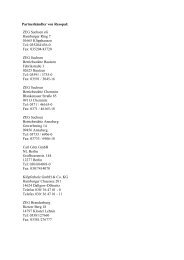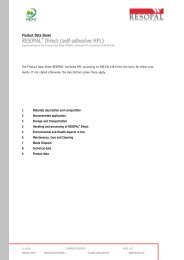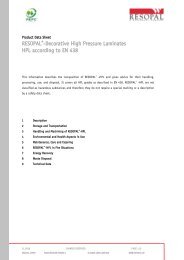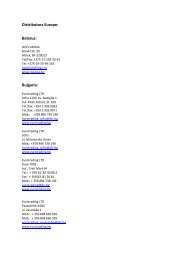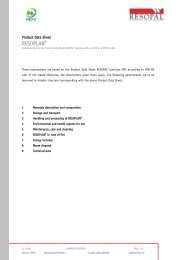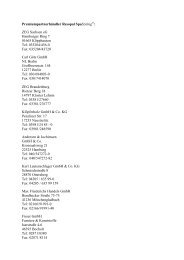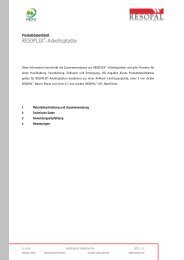Product Data Sheet RE-Y-STONE - Resopal
Product Data Sheet RE-Y-STONE - Resopal
Product Data Sheet RE-Y-STONE - Resopal
You also want an ePaper? Increase the reach of your titles
YUMPU automatically turns print PDFs into web optimized ePapers that Google loves.
<strong>Product</strong> <strong>Data</strong> <strong>Sheet</strong><br />
<strong>RE</strong>-Y-<strong>STONE</strong> ®<br />
Bio Composite Panel<br />
This information describes the composition of <strong>RE</strong>-Y-<strong>STONE</strong> ® panels and offers advice for their handling,<br />
processing, use and disposal. <strong>RE</strong>-Y-<strong>STONE</strong> ® panels are not classified as hazardous substances and there-<br />
fore they do not require a special marking or a description by a safety data sheet.<br />
1 Materials description and composition<br />
2 Storage and transport<br />
3 Handling and processing of <strong>RE</strong>-Y-<strong>STONE</strong> ®<br />
4 Environmental and health aspects for use<br />
5 Maintenance, care and cleaning<br />
6 <strong>RE</strong>-Y-<strong>STONE</strong> ® panels in case of fire<br />
7 Energy recovery<br />
8 Waste disposal<br />
9 Recycling<br />
10 Technical data<br />
02.2011 CHANGES <strong>RE</strong>SERVED PAGE 1 /6<br />
<strong>RE</strong>SOPAL GMBH HANS-BÖCKLER-STRAßE 4 D-64823 GROß-UMSTADT WWW.<strong>RE</strong>SOPAL.DE
1 Materials description and composition<br />
<strong>RE</strong>-Y-<strong>STONE</strong> ® is a bio composite panel made of recycled kraft paper and bio-resin. This new<br />
composite material is made up of renewable resources to almost 100%. Both the fibre material<br />
and the resin matrix are produced from renewable vegetable resources. Therefore, there is no<br />
direct dependence on fossil, non-renewable resources (petroleum, natural gas).<br />
The recycled paper is produced from 100% post consumer waste paper. Post consumer waste<br />
paper is paper, cardboard and/or wood fibre collected for the purpose of re-use after the respective<br />
product was used as intended.<br />
The caramel-coloured bio-resin is sugar cane resin. It is produced from plant waste occurring<br />
during sugar production, called bagasse. After curing, the bio resin has thermosetting features<br />
and forms with the natural fibres a hard, mechanically highly resilient composite material with<br />
stable dimensions.<br />
<strong>RE</strong>-Y-<strong>STONE</strong> ® are large-sized panels with resistant surfaces and homogeneous, closed trimmed<br />
edges. The bio composite panel in thicknesses of less than 3 mm can be glued to substrate materials.<br />
In larger material thicknesses, i.e. above 5 mm, they are dimensionally very stable and<br />
therefore self-supporting. With their high modulus of elasticity, this material also has the advantage<br />
of high bending strength.<br />
More than 60 % of the <strong>RE</strong>-Y-<strong>STONE</strong> ® panel is made of recycled paper; the other 30 to 40 % consist<br />
of bio-based resin.<br />
<strong>RE</strong>-Y-<strong>STONE</strong> ® is delivered in many different dimensions, thicknesses and surface structures.<br />
2 Storage and transport<br />
Storage and transport should be according to our recommendations; special safety measures are<br />
not required. <strong>RE</strong>-Y-<strong>STONE</strong> ® panels are no hazardous materials in the sense of the transport provisions,<br />
so that marking is not required.<br />
3 Handling and processing of <strong>RE</strong>-Y-<strong>STONE</strong> ®<br />
The usual safety provisions regarding de-dusting, dust-collection and fire-protection must be<br />
complied with for processing and finishing <strong>RE</strong>-Y-<strong>STONE</strong> ® .<br />
Due to possible sharp edges, always wear protective gloves when handling <strong>RE</strong>-Y-<strong>STONE</strong> ® panels.<br />
The contact to <strong>RE</strong>-Y-<strong>STONE</strong> ® dust does not cause any special problems; however, there is a limited<br />
number of people who may be sensitive or have an allergic reaction to processing dusts of<br />
all kinds.<br />
02.2011 CHANGES <strong>RE</strong>SERVED PAGE 2 /6<br />
<strong>RE</strong>SOPAL GMBH HANS-BÖCKLER-STRAßE 4 D-64823 GROß-UMSTADT WWW.<strong>RE</strong>SOPAL.DE
4 Environmental and health aspects for use<br />
<strong>RE</strong>-Y-<strong>STONE</strong> ® is a cured and thus inert thermosetting bio-plastics material. Its decorative surfaces<br />
are resistant against many usual household cleaners and chemicals.<br />
<strong>RE</strong>-Y-<strong>STONE</strong> ® panels are articles rather than chemical substances, so that the <strong>RE</strong>ACH directive is<br />
not applicable.<br />
LGA-schadstoffgeprüft<br />
<strong>RE</strong>-Y-<strong>STONE</strong> ® was certified by TÜV Rheinland LGA with the "LGA-schadstoffgeprüft" certificate.<br />
This certificate is only given to products with a very low emission of hazardous substances;<br />
they are often clearly below the statutory limits.<br />
Assessment of test results of the emission test:<br />
DIN-geprüft Biobased – for more Sustainability<br />
The sum of emissions of volatile organic compounds (TVOC) after 28<br />
days was far below the evaluation limits<br />
The sum of emissions of volatile organic compounds (STVOC) after<br />
28 days was far below the evaluation limits<br />
No CMR materials could be determined after 3 and 28 days<br />
Emission of formaldehyde and higher aldehydes after<br />
28 days was far below the evaluation limit<br />
Sustainability means, for instance, minimizing CO 2 emissions and protecting resources, and<br />
making only minimal use of finite raw materials. Bio-based products based on renewable raw<br />
materials are indispensible components of environmentally sound recycling management.<br />
Bio-based products are made from raw materials that have absorbed as much CO 2 during their<br />
growth as they emit when they are disposed of and/or burned.<br />
<strong>RE</strong>-Y-<strong>STONE</strong> ® was examined by the TÜV Rheinland Agroisolab on the basis of the ASTM D6866<br />
standard and was certified by DIN CERTCO with the "DIN-geprüft Biobased > 85%" certificate.<br />
This is the best classification, which biobased products can reach.<br />
Certification of biobased products:<br />
DIN CERTCO certifies biobased products on basis of the organic<br />
portion and the biobased carbon portion.<br />
The “DIN-Geprüft (=DIN tested)” symbol is assigned on the content<br />
on renewable raw materials. This percentage is indicated also in the<br />
appendix of the certificate and describes the portion of used biobased<br />
raw materials regarding to the total content of organic carbon.<br />
The reference of the biobased portion to the carbon portion is a<br />
standardised, approved analysis method. This value can be confirmed<br />
independently and at any time by a test.<br />
02.2011 CHANGES <strong>RE</strong>SERVED PAGE 3 /6<br />
<strong>RE</strong>SOPAL GMBH HANS-BÖCKLER-STRAßE 4 D-64823 GROß-UMSTADT WWW.<strong>RE</strong>SOPAL.DE
5 Maintenance, care and cleaning<br />
<strong>RE</strong>-Y-<strong>STONE</strong> ® surfaces are not subject to corrosion or oxidation. They do not require any further<br />
surface treatment (by varnish or paint).<br />
All decorative <strong>RE</strong>-Y-<strong>STONE</strong> ® surfaces can be cleaned with mild soap solutions. Abrasive cleaning<br />
agents (e.g. scouring powder) should be avoided.<br />
6 <strong>RE</strong>-Y-<strong>STONE</strong> ® panels in case of fire<br />
The bio-composite panels are difficult to ignite and delay spreading of flames, so that the escape<br />
time is extended. Incomplete burning may – as with any other organic material – lead to<br />
toxic substances in the smoke.<br />
In dealing with fires involving <strong>RE</strong>-Y-<strong>STONE</strong> ® the same fire fighting techniques should be employed<br />
as with any other wood based building materials.<br />
7 Energy recovery<br />
Due to the high calorific value (18 - 20 MJ/kg) *) , <strong>RE</strong>-Y-<strong>STONE</strong>® panels are particularly well suitable<br />
for energy recovery. They burn completely to water and carbon dioxide at 700°C.<br />
<strong>RE</strong>-Y-<strong>STONE</strong> ® panels burn CO 2 -neutrally. At the end of the life-cycle of <strong>RE</strong>-Y-<strong>STONE</strong>, no more carbon<br />
dioxide (CO 2 ) is released than was taken from the atmosphere by its plant components during<br />
their growth periods. The material and energy cycle is closed.<br />
<strong>RE</strong>-Y-<strong>STONE</strong> ® panels therefore not only offer all prerequisites for energy recovery according to<br />
§ 6 of the law on waste management (Kreislaufwirtschaftsgesetz). Burning offers the additional<br />
benefit of being able to save non-renewable energy carriers such as petroleum or natural gas.<br />
The conditions for good combustion processes are warranted in state of the art, authorityapproved<br />
industrial incinerators. The ash from this process can be put on controlled landfills.<br />
8 Waste disposal<br />
<strong>RE</strong>-Y-<strong>STONE</strong> ® bio composite panels can be put on controlled landfills according to the current<br />
national and/or regional regulations.<br />
9 Recycling<br />
After shredding, <strong>RE</strong>-Y-<strong>STONE</strong> ® bio composite panels can be used as filling materials in other<br />
plastics. They are particularly well suitable for producing wood-plastic composites (WPC). The<br />
name of wood-plastic composite (WPC) is usually used to describe materials or products that<br />
were made from natural fibres and a polymer.<br />
* For comparison: calorific value of fuel oil = 37 - 41 MJ/kg or of hard coal = 28 - 31 MJ/kg.<br />
02.2011 CHANGES <strong>RE</strong>SERVED PAGE 4 /6<br />
<strong>RE</strong>SOPAL GMBH HANS-BÖCKLER-STRAßE 4 D-64823 GROß-UMSTADT WWW.<strong>RE</strong>SOPAL.DE
10 Technical data<br />
10.1 Physical and Chemical Features<br />
10.1.1 Physical condition solid<br />
10.1.2 Gross density 1.4 g/cm 3<br />
10.1.3 Solubility Insoluble in water, oil, methanol, diethyl ether, n-octanol.<br />
10.1.4 Boiling point none<br />
10.1.5 Evaporation rate none<br />
10.1.6 Melting point <strong>RE</strong>-Y-<strong>STONE</strong> ® - bio-composite panels do not melt.<br />
10.1.7 Calorific value 18 - 20 MJ/kg<br />
10.1.8 Heavy metals <strong>RE</strong>-Y-<strong>STONE</strong> ® - bio-composite panels do not contain any toxic<br />
compounds based on antimony, barium, cadmium, chrome III ,<br />
chrome VI , lead, mercury, selenium.<br />
10.2 Stability and reactivity data<br />
10.2.1 Stability <strong>RE</strong>-Y-<strong>STONE</strong> ® - bio-composite panels are stable and resistant; they are<br />
neither reactive nor corrosive.<br />
10.2.2 Hazardous reactions none<br />
10.2.3 Material incompatibility Strong acids or alkaline solutions will stain the surface.<br />
10.3 Fire and Explosion Protection <strong>Data</strong><br />
10.3.1 Ignition temperature approx. 400 °C<br />
10.3.2 Flash point none<br />
10.3.3 Thermal decomposition Possible above 250 °C. Toxic gases (e.g. carbon monoxide, carbon<br />
dioxide) may appear depending on fire conditions (temperature, oxygen<br />
content, etc.).<br />
10.3.4 Smoke and toxicity Incomplete burning may – as with any other organic material – lead<br />
to toxic substances in the smoke.<br />
10.3.5 Flammability Bio-composite panels are difficult to ignite. They only burn in real<br />
fires with open flames acting on them.<br />
10.3.6 Extinguishing media The bio-composite panels are considered as class A material (burnig<br />
of solid organic materials) according to EN 2. Carbon dioxide,<br />
water jet, dry chemical foam may be used for extinguishing flames for<br />
class A material. Water suppresses and prevents repeated flaring.<br />
In case of a fire, persons should wear self breathing apparatus and<br />
fire-protection clothing.<br />
02.2011 CHANGES <strong>RE</strong>SERVED PAGE 5 /6<br />
<strong>RE</strong>SOPAL GMBH HANS-BÖCKLER-STRAßE 4 D-64823 GROß-UMSTADT WWW.<strong>RE</strong>SOPAL.DE
10.3.7 Explosion hazards Processing, sawing, sanding, milling of <strong>RE</strong>-Y-<strong>STONE</strong> ® bio-composite<br />
panels leads to class ST-1 dust. Ensure usual safety provisions and<br />
sufficient ventilation to avoid airborne dust concentration.<br />
10.3.8 Explosion threshold The dust concentration should be kept below 30 mg/m³.<br />
10.3.9 Protections against In case of fire, bio-composite panels should be treated like wood<br />
explosion and fire based materials.<br />
10.4 Electrostatic It minimises the generation of electrostatic charge by contact change<br />
behaviour or friction with other materials. It does not require any grounding<br />
connection. The surface resistance is 10 9 - 10 12 Ohm and the charge<br />
capacity according to CEI IEC 1340-4-1 is V < 2 kV. Thus, <strong>RE</strong>-Y-<strong>STONE</strong> ®<br />
is an antistatic.<br />
10.5 Storage and <strong>RE</strong>-Y-<strong>STONE</strong> ® - bio-composite panels are classified as non-hazardous<br />
transport for transportation purposes and there are no specific requirements.<br />
10.6 Processing Use gloves to protect from sharp edges and safety glasses to prevent<br />
eye injuries. No special working equipment is necessary, except protections<br />
to minimize dust exposure in case of sheet machining.<br />
10.7 Disposal considerations Waste material should be handled according to local regulations.<br />
Burning is permitted in approved industrial incinerators.<br />
10.8 Health aspects <strong>RE</strong>-Y-<strong>STONE</strong> ® bio-composite panels are not classified as hazardous for<br />
humans and animals. There is no proof for any toxic and ecotoxic effects<br />
originating from <strong>RE</strong>-Y-<strong>STONE</strong> ® -bio-composite panels.<br />
10.8.1 Working areas The usual safety provisions for dedusting shall be applied.<br />
10.8.2 Miscellaneous <strong>RE</strong>-Y-<strong>STONE</strong> ® bio-composite panels are no hazardous substance in the<br />
sense of the ordinance on hazardous substances (Gefahrstoffverordnung;<br />
GefStoffV).<br />
All information is based on the current state of technical knowledge, but it does not constitute any form of guarantee. It is the<br />
personal responsibility of the user of the products described in this information leaflet to comply with the appropriate laws and<br />
regulations.<br />
02.2011 CHANGES <strong>RE</strong>SERVED PAGE 6 /6<br />
<strong>RE</strong>SOPAL GMBH HANS-BÖCKLER-STRAßE 4 D-64823 GROß-UMSTADT WWW.<strong>RE</strong>SOPAL.DE


